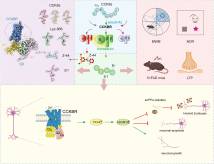
山东大学孙金鹏研究团队取得一项新突破。他们的研究揭示了阐明途径选择性偏倚CCKBR激动作用治疗阿尔茨海默病。2025年11月20日出版的《细胞》发表了这项成果。
研究团队发现CCKBR-Gs和-Gq信号,而不是CCKBR-Gi信号,对阿尔茨海默病(AD)的治疗有益。临床上,AD患者越严重,CCKBR-Gq活性越低。CCKBR与内源受体激动剂硫酸化CCK8 (CCK8s)和3种不同的G蛋白亚型复合物的冷冻电镜(cryo-EM)结构显示,不同的受体构象有助于选择性G蛋白偏压。利用这些结构的见解,研究小组合理地开发了合成CCKBR激动剂,包括Gi偏向激动剂(z-44)和Gq偏向激动剂(3r1)。值得注意的是,3r1通过改善5×FAD小鼠的认知能力下降,减少淀粉样蛋白-β斑块的数量,并通过上调α-分泌酶(ADAM10)和钙信号分子PLCB4促进长期增强(LTP),显示出治疗潜力。他们的研究结果表明,针对CCKBR-Gq信号的合成偏倚激动剂具有治疗AD的潜力。
据介绍,胆囊收缩素(CCK) B受体(CCKBR)表达于内嗅皮质(EC),在记忆和学习中起重要作用。
附:英文原文
Title: Elucidating pathway-selective biased CCKBR agonism for Alzheimer’s disease treatment
Author: Jia-Le Wang, Xue-Ying Sha, Yue Shao, Zi-Hao Zhang, Shen-Ming Huang, Hui Lin, Shi-Yi Gan, Nan Zhang, Xin-Yi Xia, Yu-Nan Sun, Jin-Hui Ding, Rui-Qi Zhao, Jie Cheng, Pan Shang, Jin-Peng Wang, Yan-Jun Liu, Fan Yang, Peng Xiao, Lu-Wen Wang, Dong-Yu Zhao, Yi Tang, Lu Tie, Yang Du, Yong Zhang, Ju-Fang He, Jin-Peng Sun
Issue&Volume: 2025-11-20
Abstract: Expressed in the entorhinal cortex (EC), the cholecystokinin (CCK) B receptor (CCKBR) plays an important role in memory and learning. Here, we identify that CCKBR-Gs and -Gq signaling, rather than CCKBR-Gi signaling, are beneficial for Alzheimer’s disease (AD) treatment. Clinically, patients with more severe AD associated with lower CCKBR-Gq activity. The cryo-electron microscopy (cryo-EM) structures of CCKBR in complex with the endogenous agonist sulfated CCK8 (CCK8s) and 3 different G protein subtypes revealed that distinct receptor conformations contribute to selective G protein bias. Leveraging these structural insights, we rationally develop synthetic CCKBR agonists, including a Gi-biased agonist (z-44) and a Gq-biased agonist (3r1). Notably, 3r1 demonstrates therapeutic potential by ameliorating cognitive decline in 5×FAD mice, reducing the number of amyloid-β plaques, and promoting long-term potentiation (LTP) via upregulation of the α-secretase (ADAM10) and the calcium signaling molecule PLCB4. Our findings suggest that synthetic biased agonists targeting CCKBR-Gq signaling have therapeutic potential for AD.
DOI: 10.1016/j.cell.2025.10.034
Source: https://www.cell.com/cell/abstract/S0092-8674(25)01238-3
